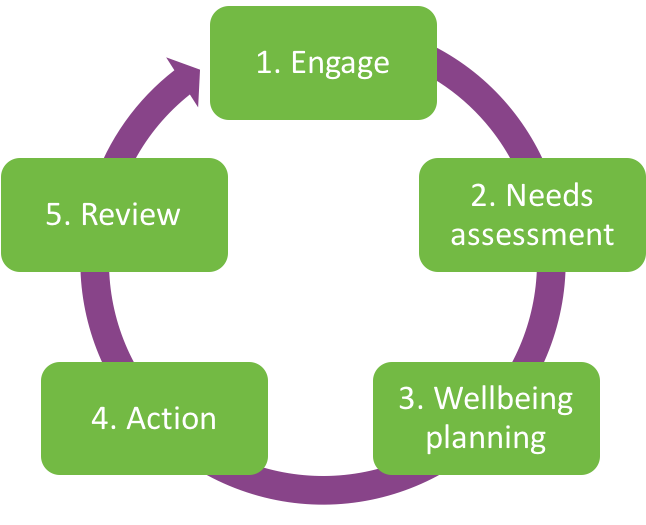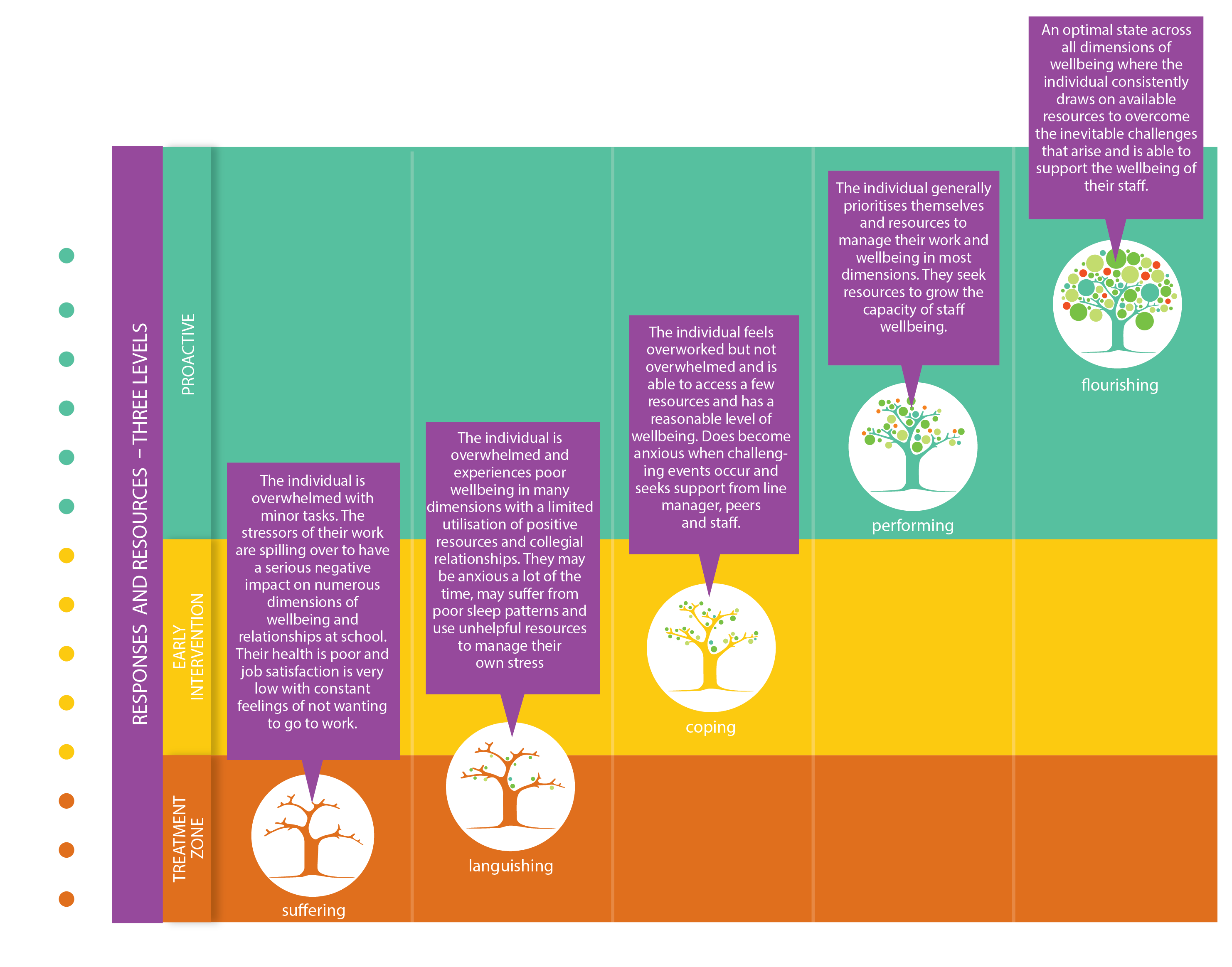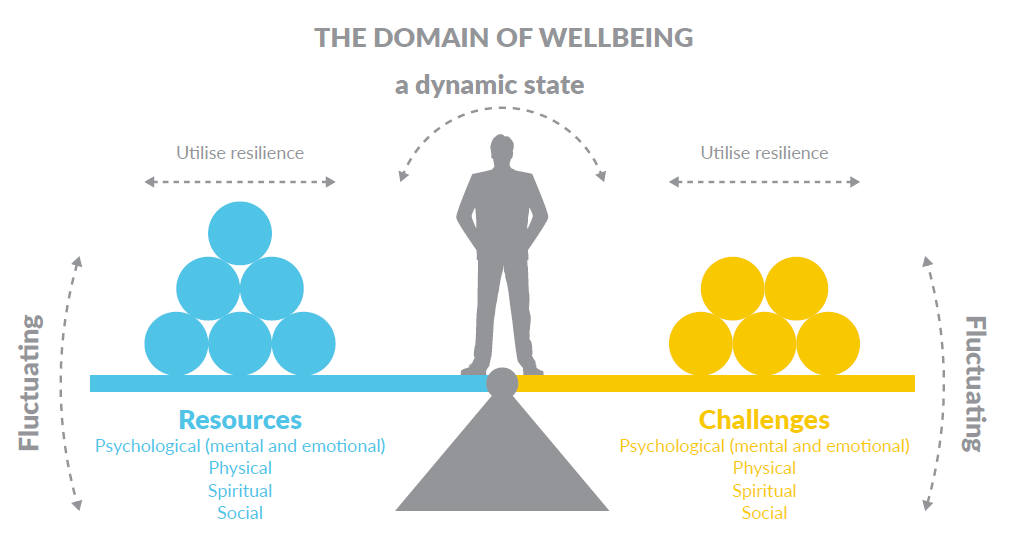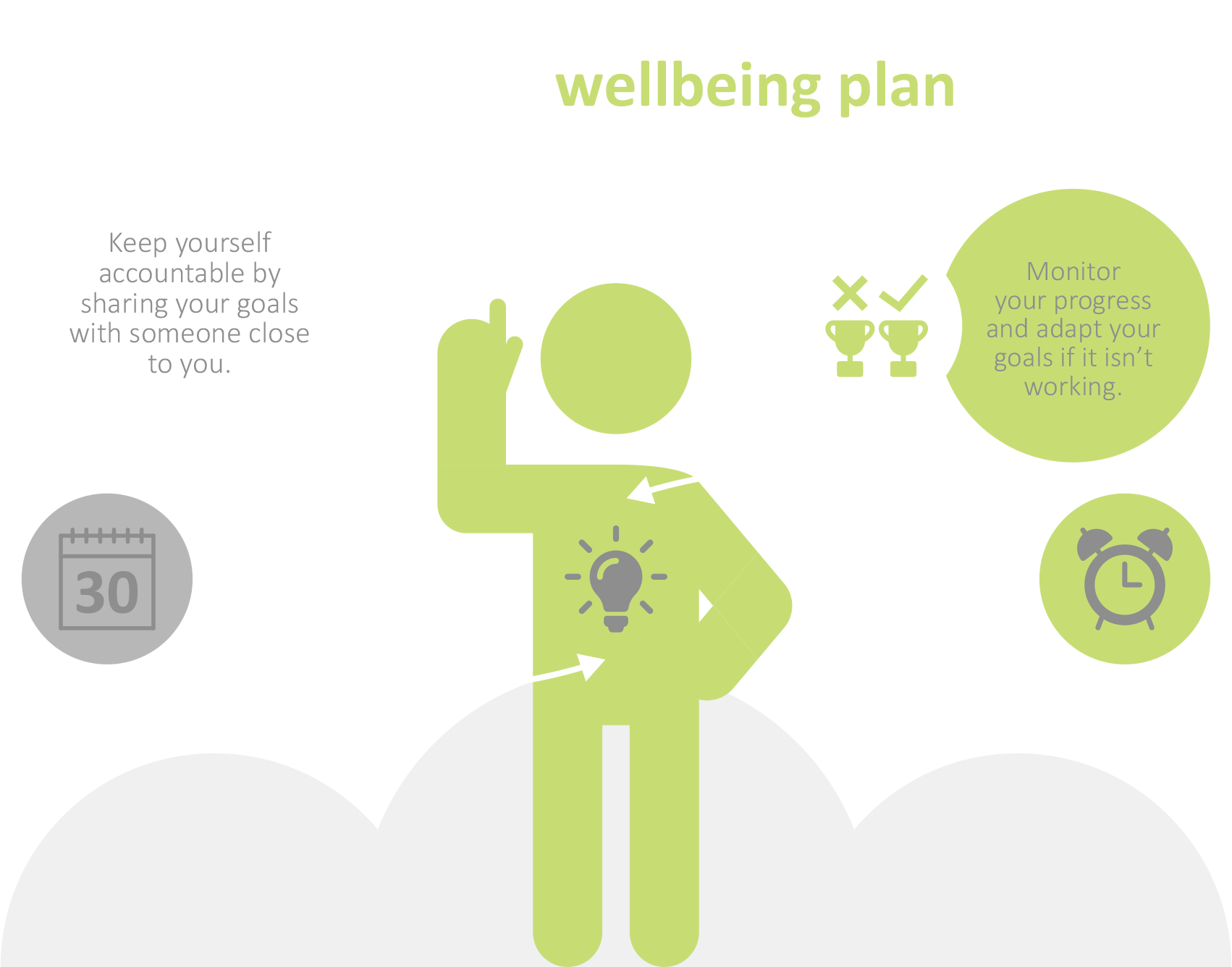Wellbeing does not just happen. It requires ongoing engagement, commitment, planning, action and review. The 5 Step process can be used to frame wellbeing planning for individual employees and the collective. To help you with the process, download the wellbeing planning template.
Did you know?
Maintaining wellbeing is an ongoing journey, you can use the 5 Step process to support the wellbeing planning process.
The 5 Step Process

Step 1 | Engage
Support yourself to flourish
The first step on your journey to wellbeing is to engage with either the Education NT Principal Wellbeing Framework or the Education NT Teacher Wellbeing Strategy and to make a commitment to your wellbeing (as an individual or as a collective).
By engaging in this process and committing to wellbeing as an individual, and as a collective, your journey will be enhanced.
Check-in with your state of wellbeing
Use the wellbeing continuum to check in with your wellbeing:

Step 1 Checklist
- Have you made a commitment to your wellbeing?
- Have you made a commitment to growing the wellbeing capability of yourself and the collective?
- Does your commitment to wellbeing contribute to building a wellbeing culture across the department?
Step 2 | Needs Assesment
Where are you starting from?
Wellbeing is a state of being. It is a person’s physical, mental, social, emotional and spiritual state1. It is important to acknowledge that wellbeing is not constant. It is dynamic and fluctuates depending on circumstance.
Since wellbeing can be impacted upon and affected by a range of factors at any given point in time, it is important to identify where you are starting from before you start your wellbeing planning.
Assessment tools for individuals
- Work on Wellbeing Assessment (free for individuals, fee applies for collective)
- Wellbeing Indicator (fee applies)
- Flourishing Profile (fee applies)
Assessment tools for the collective
- ACT Healthy Workplaces Audit Tool (free)
- QLD Healthy Places Survey (free)
- Wellbeing Indicator (fee applies)
Step 2 Checklist
- Have you completed one of the assessment tools to identify your individual and/or collective needs for wellbeing?
- Have you checked-in with your level of commitment?
1 Kaya Consulting (2015), Definition of Wellbeing, https://www.thekayagroup.com/
Step 3 | Wellbeing Planning
How can you build your wellbeing resources?
As a collective, and as individuals, our available wellbeing resources to support a flourishing state of wellbeing ebb and flow. At times, they may even be depleted. Crucially though, they can also be replenished.

Figure 1. The dynamic state of wellbeing. The relationship between challenges and resources.
Maintaining and building a flourishing state of wellbeing often comes down to an individual’s knowledge of, and access to, resources which can assist in meeting challenges. Using the results from the needs assessment, you can identify a range of resources that will build your wellbeing capability, as an individual and as a collective.
Suggestions for building your resources for the five dimensions of wellbeing:
Physical Wellbeing
- Develop a regular sleep routine
- Take regular breaks throughout the day
- Go for a walk at lunch time
- Organise walking meetings
- Encourage healthy eating options at school events
Spiritual Wellbeing
- Reflect on your purpose and values
- Try a yoga or Tai Chi class
- Become involved in a cause you are passionate about
- Communicate the school’s vision and guiding values
Social Wellbeing
- Build your social capital. Who is available?
- Prioritise close relationships in your life
- Join a new group or sporting team
- Provide regular and timely feedback to staff
Emotional Wellbeing
- Listen to music
- Participate in activities that you enjoy
- Start a gratitude journal
- Encourage staff to be reflective and include check-ins in your conversations
Mental Wellbeing
- Switch off from distractions using mindfulness techniques
- Identify and embrace your character strengths
- Set yourself achievable goals (be SMART)
- Identify and discuss opportunities for growth with staff
Step 3 Checklist
- Have you completed an individual or collective wellbeing plan?
- Is your wellbeing plan based on the results of your needs assessment?
- Have you checked-in with your level of commitment?
Step 4 | Action
Putting your plans to action and staying on track
We are all busy and have a million and two things to do. A key success factor for implementing your wellbeing plan is maintaining your commitment and engagement by planning exactly what actions you need to succeed.
Key components to consider in your action plan:
- overarching goals (What are you trying to achieve?)
- measurable objectives (What steps do you need to take to achieve your goals?)
- wellbeing strategies (What specific strategies will get us there?).
We cannot rely on simply listing our goals, objectives and strategies to achieve wellbeing. What we need to do is ensure we stay on track by developing our wellbeing resources into daily habits.

Step 4 Checklist
Have you completed a wellbeing action plan?
Accept that you cannot simply rely on your motivation to change your wellbeing, you need a specific action plan.
Start small and embed these changes into your everyday routine.
Have you identified potential blockers to your plan and considered how you will overcome these?Step 5 | Review
The value of reviewing your wellbeing plan
How will we know we are successful? What went to plan and what do we need to change for next time?
Reviewing your wellbeing plan is arguable the most important step in the process. The review process allows you to investigate the outcomes of your investment (time, effort and resources) and helps you identify how you can modify your wellbeing plan moving forward.
Wellbeing is not something you ‘get to’ or ‘achieve’, it is something that you continuously have to work for and maintain.
Therefore, reviewing your wellbeing plan is NOT the end of the 5 step process, rather it feeds directly back to Step 1; where you continue the process, growing each time you cycle through.
How often should you review your wellbeing plan?
Your wellbeing plan should be reviewed at least every school term, with some specific strategies and activities reviewed in line with your identified timelines to ensure you stay on track.
What should I review?
The review process should include:
- Repeat the needs assessment tools and compare the results (Have your results shifted? What still needs work?)
- Review your wellbeing planning template (Are you closer to your desired wellbeing state?)
- Evaluate your wellbeing action plan (Celebrate your successes and identify areas for improvement.)
Step 5 Checklist
- Have you re-completed the assessment tools from Step 2?
- Have you considered how you will review your wellbeing plan?
- Have you outlined key dates for review?
